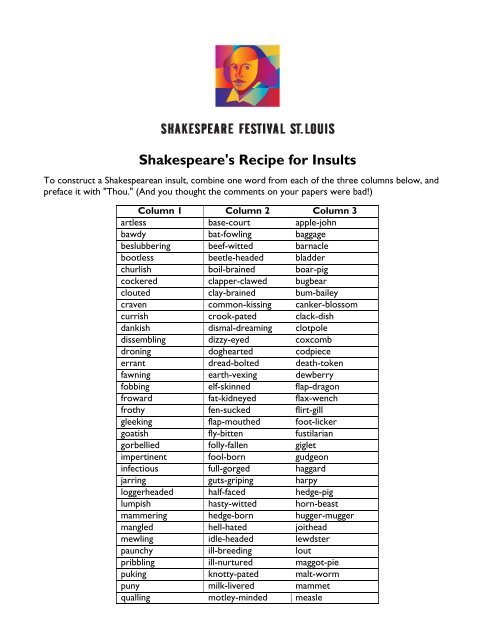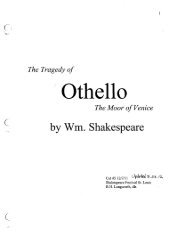Insults & Iambic Pentameter
Insults & Iambic Pentameter
Insults & Iambic Pentameter
You also want an ePaper? Increase the reach of your titles
YUMPU automatically turns print PDFs into web optimized ePapers that Google loves.
Shakespeare's Recipe for <strong>Insults</strong><br />
To construct a Shakespearean insult, combine one word from each of the three columns below, and<br />
preface it with "Thou." (And you thought the comments on your papers were bad!)<br />
Column 1 Column 2 Column 3<br />
artless base-court apple-john<br />
bawdy bat-fowling baggage<br />
beslubbering beef-witted barnacle<br />
bootless beetle-headed bladder<br />
churlish boil-brained boar-pig<br />
cockered clapper-clawed bugbear<br />
clouted clay-brained bum-bailey<br />
craven common-kissing canker-blossom<br />
currish crook-pated clack-dish<br />
dankish dismal-dreaming clotpole<br />
dissembling dizzy-eyed coxcomb<br />
droning doghearted codpiece<br />
errant dread-bolted death-token<br />
fawning earth-vexing dewberry<br />
fobbing elf-skinned flap-dragon<br />
froward fat-kidneyed flax-wench<br />
frothy fen-sucked flirt-gill<br />
gleeking flap-mouthed foot-licker<br />
goatish fly-bitten fustilarian<br />
gorbellied folly-fallen giglet<br />
impertinent fool-born gudgeon<br />
infectious full-gorged haggard<br />
jarring guts-griping harpy<br />
loggerheaded half-faced hedge-pig<br />
lumpish hasty-witted horn-beast<br />
mammering hedge-born hugger-mugger<br />
mangled hell-hated joithead<br />
mewling idle-headed lewdster<br />
paunchy ill-breeding lout<br />
pribbling ill-nurtured maggot-pie<br />
puking knotty-pated malt-worm<br />
puny milk-livered mammet<br />
qualling motley-minded measle
ank onion-eyed minnow<br />
reeky plume-plucked miscreant<br />
roguish pottle-deep moldwarp<br />
ruttish pox-marked mumble-news<br />
saucy reeling-ripe nut-hook<br />
spleeny rough-hewn pigeon-egg<br />
spongy rude-growing pignut<br />
surly rump-fed puttock<br />
tottering shard-borne pumpion<br />
unmuzzled sheep-biting ratsbane<br />
vain spur-galled scut<br />
venomed swag-bellied skainsmate<br />
villainous tardy-gaited strumpet<br />
warped tickle-brained varlet<br />
wayward toad-spotted vassal<br />
weedy unchin-snouted whey-face<br />
yeasty weather-bitten wagtail<br />
Get thee gone, thou wayward rump-fed pumpion, and make thine insults!<br />
Copyright © 2001 by The Folger Shakespeare Library<br />
"I am a pirate with a wooden leg": Stomping <strong>Iambic</strong><br />
<strong>Pentameter</strong><br />
January 2005<br />
Gregory Taylor teaches English at Hillside Junior High School in Boise, Idaho.<br />
This lesson may be used before reading any Shakespeare play or sonnet.<br />
Click here to view standards used in this lesson plan.<br />
Title page detail, Newes from sea, 1609 (anonymous).Students will learn the basics of iambic<br />
pentameter by studying the rhythm of blank verse orally, aurally, visually, and kinesthetically.<br />
This lesson will take one class period.<br />
1. Using the attached document as an overhead template, review the idea of meter. Be sure to explain<br />
the idea of "feet", the smallest repeating ryhthmic units (in Shakespeare's case, the iamb is the metrical<br />
foot.) Also teach the word "iamb", a foot of two syllables with an unstressed syllable followed by a<br />
stressed syllable.<br />
2. Introduce the term "iambic pentameter". Have the students puzzle out the meaning through<br />
morphological analysis of the component parts "meter", "iambic" and "penta" - a five foot metrical line<br />
of weak followed by strong syllables.
3. Have students repeat a line of five "I am"'s with the emphasis on the "am" syllable. Explain that this is<br />
one way to remember the iambic rhythm. Practice saying some sentences that begin with "I AM" in a<br />
weak-STRONG pattern: "I AM a great student; I AM going to be nice to my little brother."<br />
4. To really feel the iambic rhythm, get students up on their feet and say the next line, "I am a pirate<br />
with a wooden leg," dragging their wooden legs on the unstressed syllables and stepping strongly on<br />
the stressed syllables. Have students draw parentheses around the iambs and note that some divide in<br />
the middle of words: meter is about sound, not spelling.<br />
5. Have students read some lines from the play you will be reading.<br />
6. Finally, have students write their own iambic pentameter lines in pairs, as a conversation. Use the<br />
last two sentences on the handout as an example. After a few minutes, have some of the pairs perform<br />
their conversations. Be sure they understand how the meter works in this blank verse.<br />
Can students explain and demonstrate iambic pentameter? Can they write proper lines of blank verse?<br />
Can they begin to see and understand some of the uses of meter in Shakespeare's writing?<br />
Tickling the Brain<br />
------------------------------------------------------------------------<br />
January 1999<br />
Jeff Schober teaches at the Baker Road Alternative School in a suburb of Buffalo, New York. The<br />
school has approximately 80 at-risk students, grades 9-12, and few go on to higher education. Mr.<br />
Schober teaches American history and Shakespeare and co-authored a book about the Buffalo Sabres.<br />
This activity is an introduction and overview of the action in Much Ado About Nothing.<br />
Click here to view standards used in this lesson plan.<br />
Ursula, "She's lim'd, I warrant you."; Henry Fuseli, 1803, engraving.Today students will improvise a few<br />
scenarios which relate to the plot of Much Ado About Nothing. They should have no previous<br />
knowledge of the playóthey have not read any scenes or learned character names. This activity will<br />
force them to think about broad happenings they will read about, so when they begin the play they will<br />
have a base of expectations. This activity should be completed in one 40-minute period.<br />
1. Divide students into groups of four or five. Each group will be called to the front of the room and<br />
asked to improvise one of the following scenarios written on the board:<br />
A) Two people of the opposite sex, A and B, dislike one another and are constantly bickering. Show<br />
them taunting one another, then have B leave. Some friends enter. Have the friends convince A that B<br />
is really attracted to A. Deal with the matter of whether A believes them and why he (or she) would.<br />
B) A different couple, X and Y, are very much in love. Create a scenario showing their affection for<br />
one another. Have X leave and friends enter. The friends have to do something to cause Y to want to<br />
break up with X.<br />
2. Play this improvisation game as many times as necessary, depending on the number of groups you<br />
have.
3. When everyone has had a chance to act, write the names of two students who played A and B on<br />
the board. Have students copy this into their notebooks, then cross out the students' names and write<br />
Beatrice and Benedick. Do the same thing for X and Y, crossing out the students' names and inserting<br />
Hero and Claudio.<br />
4. In the remaining class time have the students copy the scenarios into their notebooks. Their<br />
homework is to write a one-page fictional story which addresses one of the scenarios.<br />
5. Collect the homework at the start of the next class period, distribute copies of the character map<br />
for Much Ado About Nothing included in the handout section below, and hand out copies of the play.<br />
Did students understand the scenarios they were asked to improvise? If they asked pointed questions<br />
which went beyond the material you covered, this is a good indication that the activity has triggered<br />
their brain. A true measure of how the lesson went should be reflected in their written assignment.<br />
Ideally they will be creative while still following the plot discussed in class.<br />
------------------------------------------------------------------------<br />
Copyright © 2001 by The Folger Shakespeare Library



